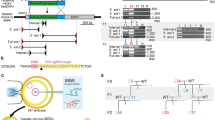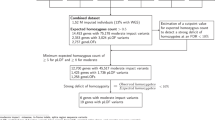Abstract
Treatment with N-ethyl-N-nitrosourea (ENU) efficiently generates single-nucleotide mutations in mice1,2,3. Along with the renewed interest in this approach, much attention has been given recently to large screens with broad aims4,5; however, more finely focused studies have proven very productive as well6,7,8. Here we show how mutagenesis together with genetic mapping can facilitate the rapid characterization of recessive loci required for normal embryonic development. We screened third-generation progeny of mutagenized mice at embryonic day (E) 18.5 for abnormalities of organogenesis. We ascertained 15 monogenic mutations in the 54 families that were comprehensively analyzed. We carried out the experiment as an outcross, which facilitated the genetic mapping of the mutations by haplotype analysis. We mapped seven of the mutations and identified the affected locus in two lines. Using a hierarchical approach, it is possible to maximize the efficiency of this analysis so that it can be carried out easily with modest infrastructure and resources.
This is a preview of subscription content, access via your institution
Access options
Subscribe to this journal
Receive 12 print issues and online access
$209.00 per year
only $17.42 per issue
Buy this article
- Purchase on Springer Link
- Instant access to full article PDF
Prices may be subject to local taxes which are calculated during checkout




Similar content being viewed by others
References
Russell, W.L. et al. Specific locus test shows ethylnitrosurea to be the most potent mutagen in the mouse. Proc. Natl Acad. Sci. USA 76, 5818–5819 (1979).
Russell, W.L., Hunsicker, P.R., Carpenter, D.A., Cornett, C.V. & Guinn, G.M. Effect of dose-fractionation on the ethylnitrosurea induction of specific-locus mutations in mouse spermatogonia. Proc. Natl Acad. Sci. USA 79, 3592–3593 (1982).
Justice, M.J., Noveroske, J.K., Weber, J.S., Zheng, B. & Bradley, A. Mouse ENU mutagenesis. Hum. Mol. Genet. 8, 1955–1963 (1999).
Nolan, P.M. et al. A systematic, genome-wide, phenotype-driven mutagenesis programme for gene function studies in the mouse. Nature Genet. 25, 440–444 (2000).
Hrabe de Angelis, M.H. et al. Genome-wide, large-scale production of mutant mice by ENU mutagenesis. Nature Genet. 25, 444–447 (2000).
Kasarskis, A., Manova, K. & Anderson, K.V. A phenotype-based screen for embryonic lethal mutations in the mouse. Proc. Natl Acad. Sci. USA 95, 7485–7490 (1998).
Hentges, K., Thompson, K. & Peterson, A. The flat-top gene is required for the expansion and regionalization of the telencephalic primordium. Development 126, 1601–1609 (1999).
Favor, J. & Neuhauser-Klaus, A. Saturation mutagenesis for dominant eye morphological defects in the mouse Mus musculus. Mamm. Genome 11, 520–525 (2000).
Neuhaus, I. & Beier, D. Efficient localization of mutations by interval haplotype analysis. Mamm. Genome 9, 150–154 (1998).
Takeshima, H. et al. Excitation-contraction uncoupling and muscular degeneration in mice lacking functional skeletal muscle ryanodine-receptor gene. Nature 369, 556–559 (1994).
Kusumi, K. et al. The mouse pudgy mutation disrupts Delta homologue Dll3 and initiation of early somite boundaries. Nature Genet. 19, 274–278 (1998).
Hrabe de Angelis, M., McIntyre, J. & Gossler, A. Maintenance of somite borders in mice requires the Delta homologue DII1. Nature 386, 717–721 (1997).
Beckers, J., Schlautmann, N. & Gossler, A. The mouse rib-vertebrae mutation disrupts anterior-posterior somite patterning and genetically interacts with a Delta1 null allele. Mech. Dev. 95, 35–46 (2000).
Lu, W. et al. Perinatal lethality with kidney and pancreas defects in mice with a targetted Pkd1 mutation. Nature Genet. 17, 179–181 (1997).
Wu, G. et al. Somatic inactivation of Pkd2 results in polycystic kidney disease. Cell 93, 177–188 (1998).
Turco, A.E., Rossetti, S., Bresin, E., Englisch, S., Corra, S. & Pignatti, P.F. Three novel mutations of the PKD1 gene in Italian families with autosomal dominant polycystic kidney disease. Hum. Mutat. 10, 164–167 (1997).
Daniells, C., Maheshwar, M., Lazarou, L., Davies, F., Coles, G. & Ravine, D. Novel and recurrent mutations in the PKD1 (polycystic kidney disease) gene. Hum. Genet. 102, 216–220 (1998).
Sporle, R., Gunther, T., Struwe, M. & Schughart, K. Severe defects in the formation of epaxial musculature in open brain (opb) mutant mouse embryos. Development 122, 79–86 (1996).
Sporle, R. & Schughart, K. Paradox segmentation along inter- and intrasomitic borderlines is followed by dysmorphology of the axial skeleton in the open brain (opb) mouse mutant. Dev. Genet. 22, 359–373 (1998).
Eggenschwiler, J.T., Espinoza, E. & Anderson, K.V. Rab23 is an essential negative regulator of the mouse Sonic hedgehog signalling pathway. Nature 412, 194–198 (2001).
Bode, V.C., McDonald, J.D., Guenet, J.L. & Simon, D. hph-1: a mouse mutant with hereditary hyperphenylalaninemia induced by ethylnitrosourea mutagenesis. Genetics 118, 299–305 (1988).
Luna, l.J. Manual of Histologic Staining Methods of the Armed Forces Institute of Pathology (McGraw-Hill, New York, 1960).
McLeod, M.J. Differential staining of cartilage and bone in whole mouse fetuses by Alcian Blue and Alizarin Red S. Teratology 22, 299–301 (1980).
Acknowledgements
We thank K. Simms, J. Kim, S. Kuida and A. Salinger for their contributions to this project. This work was supported by grants from the National Institutes of Health (M.J.J. and D.R.B.).
Author information
Authors and Affiliations
Corresponding author
Supplementary information
Rights and permissions
About this article
Cite this article
Herron, B., Lu, W., Rao, C. et al. Efficient generation and mapping of recessive developmental mutations using ENU mutagenesis. Nat Genet 30, 185–189 (2002). https://doi.org/10.1038/ng812
Received:
Accepted:
Published:
Issue Date:
DOI: https://doi.org/10.1038/ng812
This article is cited by
-
Thm2 interacts with paralog, Thm1, and sensitizes to Hedgehog signaling in postnatal skeletogenesis
Cellular and Molecular Life Sciences (2021)
-
Variant mapping and mutation discovery in inbred mice using next-generation sequencing
BMC Genomics (2015)
-
Ouabain Regulates CFTR-Mediated Anion Secretion and Na,K-ATPase Transport in ADPKD Cells
The Journal of Membrane Biology (2015)
-
Translational research in ADPKD: lessons from animal models
Nature Reviews Nephrology (2014)
-
Exploiting the power of LINE-1 retrotransposon mutagenesis for identification of genes involved in embryonic stem cell differentiation
Stem Cell Reviews and Reports (2014)



